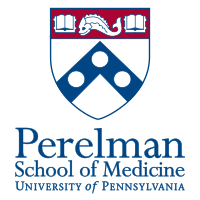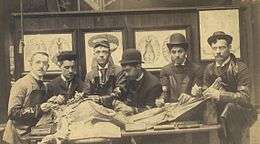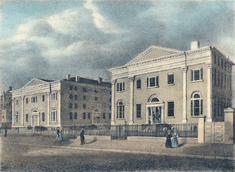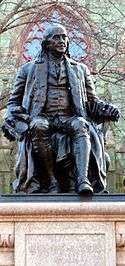Perelman School of Medicine at the University of Pennsylvania
 | |
Other name | Penn Med |
|---|---|
| Type | Private medical school |
| Established | 1765[1] |
Parent institution | University of Pennsylvania |
| Affiliation | University of Pennsylvania Health System[1] |
| Dean | J. Larry Jameson[1] |
| Executive Vice Dean | Jonathan Epstein |
Academic staff |
2,100 (full-time)[1] 1,200 (residents and fellows)[1] |
Administrative staff | 3,334[1] |
| Students |
775 M.D. students 594 Ph.D. students 186 M.D.-Ph.D. students 329 masters students 704 post-doctoral fellows[1] |
| Address |
3400 Civic Center Boulevard, Philadelphia, PA, 19104, US 39°56′51″N 75°11′32″W / 39.947454°N 75.192356°WCoordinates: 39°56′51″N 75°11′32″W / 39.947454°N 75.192356°W |
| Campus | Urban |
The Perelman School of Medicine, commonly known as Penn Med, is the medical school of the University of Pennsylvania. It is located in the University City section of Philadelphia. Founded in 1765, the Perelman School of Medicine is the oldest medical school in the United States.[2] Today, it is a major center of biomedical research and education, and it is widely regarded as one of the country's top medical schools. Penn Med consistently ranks among the highest recipients of NIH research awards,[3] and currently ties for 6th on U.S. News & World Report's "Best Medical Schools: Research" list .[4]
History
The school of medicine was founded by Dr. John Morgan, a graduate of the College of Philadelphia (A.B. 1757) and the University of Edinburgh Medical School (M.D. 1763).[5] In 1765, after training in Edinburgh and other European cities, Dr. Morgan returned to Philadelphia. With fellow University of Edinburgh Medical School graduate Dr. William Shippen Jr., Morgan persuaded the Trustees of the University of Pennsylvania to found the first medical school in the Original Thirteen Colonies. Only months before the medical school was created, Morgan delivered an address to the Trustees and the citizens of Philadelphia, "Upon the Institution of Medical Schools in America" during which he expressed his desire for the new medical school to become a model institution:[6]
Perhaps this medical institution, the first of its kind in America, though small in its beginning, may receive a constant increase of strength, and annually exert new vigor. It may collect a number of young persons of more ordinary abilities, and so improve their knowledge as to spread its reputation to different parts. By sending these abroad duly qualified, or by exciting an emulation amongst men of parts and literature, it may give birth to other useful institutions of a similar nature, or occasional rise, by its example to numerous societies of different kinds, calculated to spread the light of knowledge through the whole American continent, wherever inhabited.[7]
That autumn, students enrolled for "anatomical lectures" and a course on "the theory and practice of physick." Modeling the School after the University of Edinburgh Medical School, the need for supplemental medical lectures with bedside teaching was emphasized, which was satisfied by practitioners at the Pennsylvania Hospital.[8]

The School of Medicine's faculty was nationally renowned: Benjamin Rush (medicine), Philip Syng Physick (surgery), Robert Hare (chemistry), and, around the 1850s, William Pepper (medicine) and Joseph Leidy (anatomy). In 1847, the group of physicians who organized the American Medical Association effectively gave recognition to the School's fame by naming the AMA's first president Nathaniel Chapman, Professor of Medicine at the School.[9]
Name
In 2011, the University of Pennsylvania School of Medicine was renamed in recognition of a $225 million gift by Raymond and Ruth Perelman. Raymond Perelman and his son, billionaire Ronald Perelman, are both alumni of Penn's Wharton School.[10] It was the single largest gift made in the University's history, and it remains the largest donation ever made for naming rights to a medical school.[11]
Campus

In the 1870s, the university closed its campus in Center City, Philadelphia and established a new location across the Schuylkill River in West Philadelphia, just north of the Blockley Almshouse. As part of this move, the School of Medicine's faculty persuaded the University's trustees to build a teaching hospital on the new campus, the Hospital of the University of Pennsylvania (HUP).[12] Today, the medical school is affiliated with the Hospital of the University of Pennsylvania, Penn Presbyterian Medical Center, Pennsylvania Hospital, Chester County Hospital, and the Children's Hospital of Philadelphia with additional teaching at the Philadelphia VA Medical Center.[13][14][15]
The Penn School of Nursing building and the Philadelphia Medical Examiner's Office are both located within the School of Medicine complex.
Medical advancements
During the late nineteenth and early twentieth centuries, the School of Medicine was one of the earliest to encourage the development of the emerging medical specialties: neurosurgery, ophthalmology, dermatology, and radiology. Between 1910 and 1939, the chairman of the Department of Pharmacology, Alfred Newton Richards, played a significant role in developing the University as an authority of medical science, helping the United States to catch up with European medicine and begin to make significant advances in biomedical science.
In the 1950s and early 1960s, Dr. Jonathon E. Rhoads of the Department of Surgery (which he would later go on to head for many years), mentored Dr. Stanley Dudrick who pioneered the successful use of total parenteral nutrition (TPN) for patients unable to tolerate nutrition through their GI tract.[16]
In the 1980s and 1990s, Dr. C. William Schwab, a trauma surgeon, led numerous advances in the concept of damage control surgery for severely injured trauma patients.[17]
In the 1990s and 2000s, Dr. Paul Offit, a professor of Pediatrics at the School of Medicine and Children's Hospital of Philadelphia, lead the scientific advances behind the modern RotaTeq vaccine for infectious childhood diarrhea.
In 2006, Drs. Kaplan and Shore of the Department of Orthopedics discovered the causative mutation in fibrodysplasia ossificans progressiva, an extremely rare disease of bone.[18]
Medical curriculum
Benchmark changes in the understanding of medical science and the practice of medicine have necessitated that the school change its methods of teaching, as well as its curriculum. Large changes were made in 1968, 1970, 1981, 1987, and 1997. The last significant change in 1997 brought about the institution of Curriculum 2000, "an integrated, multidisciplinary curriculum which emphasizes small group instruction, self directed learning and flexibility." Three themes, Science of Medicine, Art and Practice of Medicine, and Professionalism and Humanism, were developed by focus groups consisting of department chairpersons, course directors, and students.[19]
Biomedical Graduate Studies
Biomedical Graduate Studies, contained within the Perelman School of Medicine, was established in 1985 and serves as the academic home within the University of Pennsylvania for roughly 700 students pursuing a PhD in the basic biomedical sciences. BGS consists of more than 600 faculty members across seven Penn schools and several associated institutes including Wistar Institute, Fox Chase Cancer Center, and Children's Hospital of Philadelphia.[20] There are eight graduate programs, labeled by the school as "graduate groups," that lead to a Ph.D. in basic biomedical sciences.[21]
- Biochemistry and Molecular Biophysics
- Bioengineering
- Cell and Molecular Biology
- Epidemiology and Biostatistics
- Genomics and Computational Biology
- Immunology
- Neuroscience
- Pharmacology
All biomedical graduate studies students receive a stipend in addition to a full fellowship and tend to receive the degree within a median time frame of 5.4 years.[22] There is also the option for students to pursue an additional certificate in medicine, public health, and environmental health sciences.[23] Each graduate group has its own admission policy and training mission, and hence curriculum greatly varies.[20]
Governance
"Penn Medicine" is the governing board that administers and coordinates the Perelman School of Medicine and the University of Pennsylvania Health System (UPHS). The board reports directly to the trustees of the University of Pennsylvania. It was created by Penn's former president, Judith Rodin, in response to a $300 Million financial crisis at the Health System.[24]
Departments
The School of Medicine has departments in the following basic science subjects: Biochemistry and Biophysics, Biostatistics and Epidemiology, Cancer Biology, Cell and Developmental Biology, Genetics, Medical Ethics and Health Policy, Microbiology, Neuroscience, Pharmacology, and Physiology. The school also has departments in the following clinical practices: Anesthesiology and Critical Care, Dermatology, Emergency Medicine, Family Practice and Community Medicine, Medicine, Neurology, Neurosurgery, Obstetrics and Gynecology, Ophthalmology (See Scheie Eye Institute), Orthopaedic Surgery, Otorhinolaryngology, Pathology and Laboratory Medicine, Pediatrics (See Children's Hospital of Philadelphia), Physical Medicine and Rehabilitation, Psychiatry, Radiation Oncology, Radiology, and Surgery.[25]
Centers and institutes
The Perelman School of Medicine, in conjunction with the University of Pennsylvania Health System, has contained within it many centers and institutes dealing with clinical medicine, clinical research, basic science research, and translational research.[26]
Notable alumni
See also
References
- 1 2 3 4 5 6 7 "Overview". Trustees of the University of Pennsylvania. Retrieved April 14, 2017.
- ↑ "University of Pennsylvania". World Digital Library. Retrieved 14 February 2013.
- ↑ "NIH Awards by Location & Organization, Medical Schools Only". National Institutes of Health. Retrieved 10 September 2012.
- ↑ "University of Pennsylvania (Perelman) | Best Medical School". U.S. News & World Report. Retrieved April 4, 2018.
- ↑ Carson, Joseph (1869). A History of the Medical Department of the University of Pennsylvania. Philadelphia, Pennsylvania: Lindsay and Blakiston. p. 44. LCCN 08007557. OCLC 2340581.
- ↑ Thorpe, Francis M. (July 1985). "The University of Pennsylvania" (Magazine). Harper's Magazine. p. 289. Retrieved 19 October 2011.
- ↑ Morgan, John (1765). A Discourse upon the Institution of Medical Schools in America. Philadelphia: William Bradford. LCCN 07027987. OCLC 62815747.
- ↑ Nitzsche, George Erazmus (1918). University of Pennsylvania: its history, traditions, buildings and memorials (7th ed.). Philadelphia, PA: International Printing Company. p. 13.
- ↑ Frances Gurney Smith; John B. Biddle, eds. (1853). The Medical examiner, and record of medical science, Volume 9. Philadelphia, PA: Lindsay & Blakiston. pp. 532–5. Retrieved 19 October 2011.
- ↑ "Penn Gets $225 Million for Its School of Medicine". The New York Times. 11 May 2011.
- ↑ "Raymond and Ruth Perelman Donate $225 Million to the University of Pennsylvania's School of Medicine".
- ↑ "School of Medicine, A Brief History". University of Pennsylvania. Retrieved 29 October 2011.
- ↑ "University of Pennsylvania (Perelman)". Best Medical Schools. U.S. News & World Report. 2015. Retrieved March 18, 2015.
- ↑ "Medical Student Elective Rotations". chop.edu. Children's Hospital of Philadelphia. Retrieved March 18, 2015.
- ↑ "About the Philadelphia VA Medical Center". philadelphia.va.gov. U.S. Department of Veteran's Affairs. Retrieved March 18, 2015.
- ↑ "Death of Dr. Jonathan Rhoads, A Preeminent Penn Paragon". University of Pennsylvania Almanac. 8 January 2002. Retrieved November 25, 2011.
- ↑ "C. William Schwab, M.D., F.A.C.S., F.R.C.S. Traumatology, Surgical Critical Care and Emergency Surgery". Penn Medicine.
- ↑ Shore, EM (May 2006). "A recurrent mutation in the BMP type I receptor ACVR1 causes inherited and sporadic fibrodysplasia ossificans progressiva". Nature Genetics. 38 (5): 525–7. doi:10.1038/ng1783. PMID 16642017.
- ↑ http://www.med.upenn.edu/history.html
- 1 2 "About". Biomedical Graduate Studies. University of Pennsylvania. Retrieved 28 October 2011.
- ↑ "BGS Overview". Biomedical Graduate Studies. University of Pennsylvania. Retrieved 28 October 2011.
- ↑ "A Data-Based Assessment of Research-Doctorate Programs in the United States". The National Academies Press. Retrieved 28 October 2011.
- ↑ "Certificate". Biomedical Graduate Studies. University of Pennsylvania. Retrieved 28 October 2011.
- ↑ "Gazette - Feature: The Rodin Years".
- ↑ "Departments". Perelman School of Medicine. University of Pennsylvania. Retrieved 28 October 2011.
- ↑ "Centers and Institutes". Perelman School of Medicine. University of Pennsylvania. Retrieved 28 October 2011.
External links
| Wikimedia Commons has media related to Perelman School of Medicine at the University of Pennsylvania. |
![]()
- A History of the Medical Department of the University of Pennsylvania (1869) by Joseph Carson, M.D.
- The History of the University of Pennsylvania (1834) by George B. Wood, M.D.
- A Discourse upon the Institution of Medical Schools in America (1765) by John Morgan, M.D.
